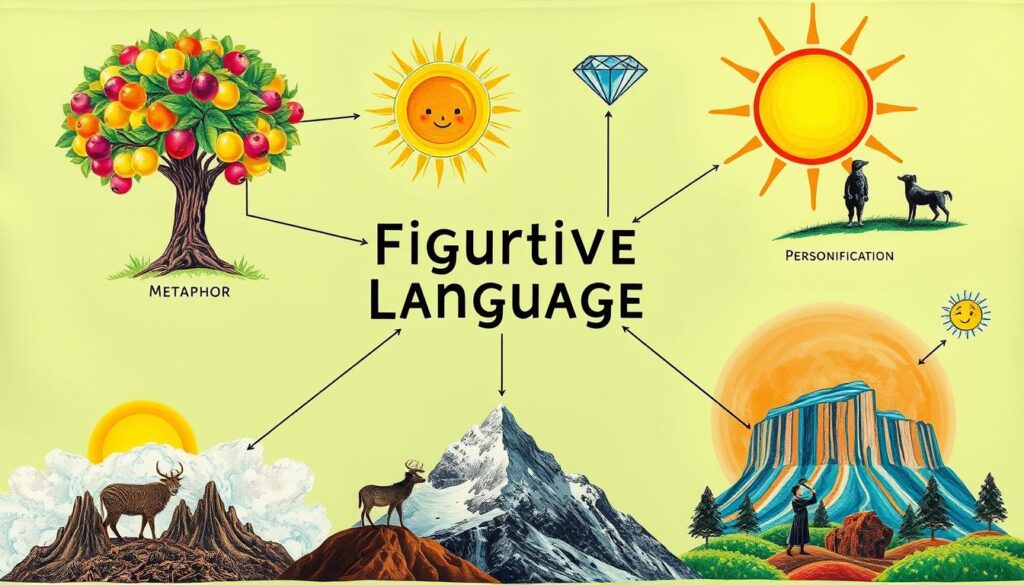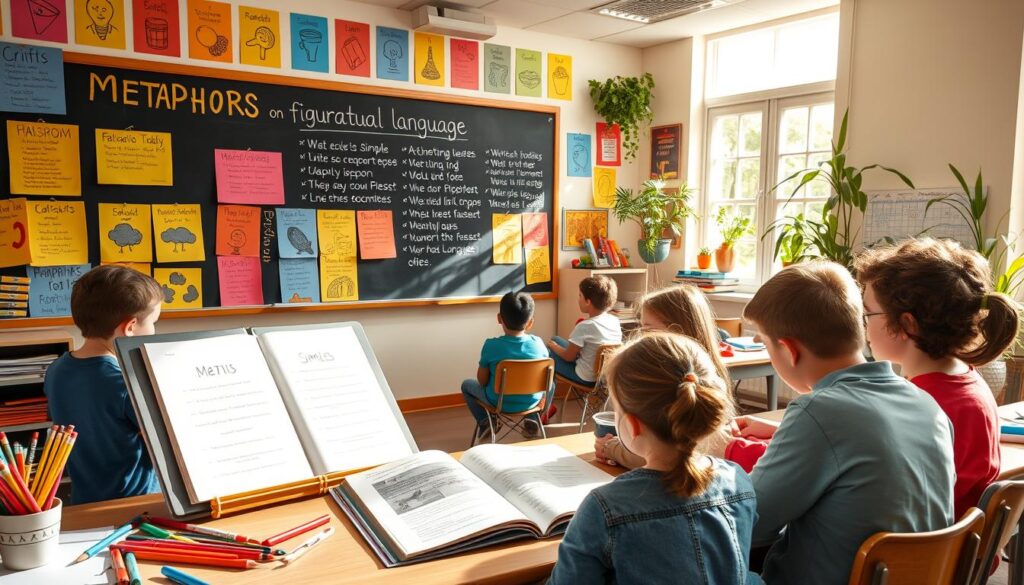Imagine a classroom where students’ eyes light up with excitement. They unravel the mysteries of figurative language. This is the power of introducing metaphors and similes to young minds.
It transforms how they see the world. As an English teacher, you can ignite this spark. Guide your students on a journey of exploration.
They’ll learn to use metaphors and similes to improve their writing and understanding. In a recent survey, 87% of teachers saw a big increase in their students’ love for creative writing. This happened after they explored figurative language.
Ms. Emily Richardson, a teacher, shared her story. She started using metaphor and simile lessons in her 5th-grade class. She was amazed at how quickly her students’ writing improved.
They moved from using simple descriptions to creating vivid pictures with their words. Their confidence in expressing themselves grew a lot.
Key Takeaways
- Discover engaging lesson plans to introduce metaphors and similes to your English students.
- Explore creative writing activities and projects that bring figurative language to life.
- Gain access to a wealth of teacher resources, including standards alignment and differentiated learning experiences.
- Empower your students to master the art of using metaphors and similes effectively in their writing and speech.
- Foster a love for literature and language arts through the dynamic exploration of figurative devices.
Understanding Figurative vs. Literal Language
Before we explore different types of figurative language, let’s grasp the key difference between literal and figurative language. Literal language tells us things straight, giving facts or descriptions without any secret meanings. On the other hand, figurative language uses words to mean more than what they say, making our messages richer and more vivid.
READ MORE – Engaging English Lessons for 8th-10th Grade
Defining Literal and Figurative Language
Literal language is clear and direct, telling us exactly what it says. For instance, “The sun is shining brightly today.” This statement just tells us the weather without any hidden messages. Figurative language, however, uses words in creative ways to paint pictures, stir feelings, or make comparisons. It brings a touch of imagination and creativity to our words.
Examples of Literal and Figurative Statements
Let’s look at some examples to see the difference:
- Literal: “The cat is sitting on the mat.”
- Figurative: “The cat is as graceful as a ballerina.”
- Literal: “The book is on the table.”
- Figurative: “The book is a window to another world.”
Introducing Types of Figurative Language
Figurative language includes metaphors, similes, personification, hyperbole, and idioms. These tools help us express ideas in creative and captivating ways. They grab our attention and share deeper meanings.

Knowing the difference between literal and figurative language is key to exploring the world of figurative language teaching resources. It helps students learn to use and understand literal vs. figurative language and its examples well.
Introducing Similes and Metaphors
Similes and metaphors are key figures of speech that make language richer and more creative. It’s important for students to know the difference between them. This knowledge helps in using them well.
Defining Similes and Metaphors
A simile compares two different things using “like” or “as.” For example, “Her eyes were as bright as the stars” or “He ran like the wind.” A metaphor, however, says one thing is another directly, without “like” or “as.” For instance, “The classroom was a zoo” or “Time is money.”
Providing Examples for Understanding
- Simile: “Her smile was as warm as the summer sun.”
- Metaphor: “The evening sky was a canvas of brilliant colors.”
- Simile: “The puppy’s fur was as soft as a cloud.”
- Metaphor: “The football player was a lion on the field.”
By looking at these examples, students can start to understand similes and metaphors. This knowledge is the first step in learning more about figurative language.

“Metaphors have a way of holding the most truth in the least space.” – Orson Scott Card
Identifying Similes and Metaphors in Text
Poems, songs, and picture books are great for learning about similes and metaphors. By reading and talking about the figurative language in these texts, students see how similes and metaphors make communication richer.
Using Poems for Exploration
Begin by showing students poems with similes and metaphors. The Poetry Foundation and Poets.org have lots of poems to choose from. Ask students to find the similes and metaphors and talk about how they add meaning and pictures to the text.
Analyzing Song Lyrics for Practice
Songs are also a great way to learn about similes and metaphors. Artists like Taylor Swift and Lin-Manuel Miranda use figurative language in their songs. Give students song lyrics and have them find the similes and metaphors. Explain how these help carry the song’s message and mood.
Exploring Picture Books as Mentor Texts
Picture books are also good for learning about similes and metaphors. They help make stories more vivid and emotional. Books like “The Dot” by Peter H. Reynolds and “Giraffe Problems” by Jory John are great examples.
By looking at different types of texts, students learn how similes and metaphors are used in real life. This helps them understand and spot these literary devices with ease.
Interactive Activities for Practice
Engaging activities are key to mastering similes and metaphors. The Similes and Metaphors Scavenger Hunt is a great example. It turns students into literary detectives, searching for these devices in texts and everyday items.
This activity can be adjusted for different ages and learning styles. Younger students might get a list to follow, while older ones can search on their own. It can also include other figurative language types like personification and hyperbole.
Teachers can also use other fun activities. For instance, a “Figurative Language Awards Ceremony” lets students share examples and explain their meanings. This boosts their understanding and encourages them to think deeply about language.
By adding these activities to their lessons, teachers can make learning exciting. This approach helps students appreciate the impact of similes and metaphors in language.
Lesson Plans for English Metaphors and Similes
Teaching metaphors and similes in the English classroom can be exciting. Lesson plans help students understand these literary tools. They are designed for different grade levels, making learning fun and structured.
Lesson plans for grades 3-5 and middle school are plentiful. They include 10 to 23 quotes for analysis. For example, Grade 3 students learn from Robert Francis’s “The Base Stealer.”
Students enjoy activities like making similes and guessing who wrote them. They also learn to spot figurative language in poems by famous poets.
Some resources offer printable handouts, like one for “A Visit from St. Nicholas” by Clement Clarke Moore. This handout asks students to find similes and metaphors. There are also lessons on teaching poetry through riddles and various literary devices.
| Resource | Key Features |
|---|---|
| 37-slide PowerPoint on similes and metaphors | Provides examples from famous literary works, such as Wordsworth’s “I Wandered Lonely As a Cloud,” Coleridge’s “The Ancient Mariner,” and Burns’ “My Luv is Like a Red, Red Rose.” |
| Accompanying worksheets | Contains 16 tasks focused on identifying similes and metaphors in sentences and poetry, including texts like “The Ancient Mariner,” Shakespeare quotes, and verses from the Bible. |
| Explanation sheet | Differentiates between similes and metaphors with corresponding examples. |
These lesson plans for teaching metaphors and similes in the English language arts classroom are a great resource. They help educators teach these important tools in a fun and engaging way.

Using Picture Books for Mini-Lessons
Picture books are great for teaching similes and metaphors. They make learning fun and easy for students of all ages. By choosing the right books, teachers can teach important concepts and show how similes and metaphors add depth to stories.
Recommended Picture Books
There are many picture books that are perfect for teaching similes and metaphors. Some top picks include:
- My Dog Is as Smelly as Dirty Socks by Hanoch Piven
- Chocolate Me! by Taye Diggs
- The Poet’s Dog by Patricia MacLachlan
- The Farmer and the Clown by Marla Frazee
- The Three Questions by Jon J Muth
Teaching Process with Picture Books
Teaching similes and metaphors with picture books is easy and fun:
- Start by reading the chosen book aloud. This lets students dive into the story and pictures.
- Then, talk about the similes and metaphors in the book. Ask students to share how these phrases make the story better.
- Next, ask students to come up with their own similes and metaphors. They can work alone or in groups.
Using picture books makes learning similes and metaphors fun and memorable. It helps students understand and enjoy these literary tools.

Writing Projects for Application
After learning the difference between similes and metaphors, students need to practice using them. This section talks about a project where students write poems with these devices. They brainstorm words to create their own figurative language, showing they understand and can use these tools well.
Creating Simile and Metaphor Poems
Writing poems with similes and metaphors lets students show their creativity and learn more about these devices. Start by having students brainstorm words for their figurative language. Encourage them to think of unique and creative comparisons.
Then, have them put their words into similes and metaphors. Show them examples of poems that use these devices to inspire them. As they write, remind them to use vivid language to paint a picture for the reader.
Finally, let students share their poems with the class. They can read them aloud or show them on a classroom wall. This celebrates their work and lets their peers see how similes and metaphors are used in writing.
This project helps students understand and use similes and metaphors better. It also improves their writing skills, like choosing words and being creative. This activity is a great way for students to show they’ve mastered these poetic techniques.
Reinforcement and Challenge Activities
To make sure students remember the difference between similes and metaphors, it’s key to keep reinforcing the lesson. We need to give them chances to find and use these literary tools. This part talks about ways to make students understand figurative language better.
Identifying Figurative Language in Read-Alouds
When reading aloud, stop at key moments to talk about similes, metaphors, and other figurative language. Ask students to listen for these and share what they find. This makes them better at spotting figurative language in real texts, which helps them remember what they’ve learned.
Student-Driven Figurative Language Display
Ask students to make a display in class about similes, metaphors, and other figurative language they find in their reading. They should collect examples, explain them, and show how they work. This project not only helps them understand better but also makes them feel more connected to the material.
Exploring Idioms as Figurative Language
Similes and metaphors are familiar, but idioms are also worth exploring. Teach students about common idioms and their meanings. Challenge them to find idioms in texts and learn about their history and cultural background. This helps them see how rich and complex figurative language can be.
By using these activities, you can help students really get similes, metaphors, and other figurative language. The aim is to make them appreciate the power of language and how it can mean more than just the words.
Differentiated Learning Experiences
This unit on similes and metaphors caters to all students. It offers a variety of activities. Students can show their grasp of figurative language through multimedia, coding, and analyzing primary sources.
Make-a-Movie Project
Students make a video of a poem with similes and metaphors. This lets them bring the language to life. They can show off their skills in using these literary tools.
Make-a-Map Activity
Students describe their favorite season using similes and metaphors. They make a “spider map” to show their creativity. This helps them understand and use figurative language.
Creative Coding with Figurative Language
Students write a news headline with a simile or metaphor. This coding task makes them think about language’s power. It shows how to use figurative language to grab attention.
Primary Source Analysis
Students study a historical poem to understand similes and metaphors. They see how these elements shape the poem’s meaning and mood. This deepens their appreciation for figurative language.
This unit makes sure all students can learn and show their skills in similes and metaphors. It offers many ways to engage with these concepts.
Extending Learning with Writing Units
Teachers can use similes and metaphors to help students grow in their writing skills. By exploring these tools in different writing styles, students learn to use them well. This makes their writing more engaging and expressive.
Students can reflect on their writing journey at key moments. They might analyze “The Writer” by Richard Wilbur to find extended metaphors. Projects can include making a scrapbook, designing a CD cover, or writing a short story. All these projects focus on a metaphor that shows who they are as writers.
These writing units help students think deeply about their writing. They learn to analyze poetry and share their thoughts. Students also work on projects that use similes and metaphors, improving their understanding of language.
Engaging with Figurative Language in Writing
- Analyze poetry, such as “The Writer” by Richard Wilbur, to identify and explore extended metaphors
- Reflect on personal writing processes and share responses in small groups
- Compose texts based on chosen metaphors, including scrapbooks, CD covers, papers, or short stories
Extending Learning Opportunities
- Justifying the use of simile, metaphor, and personification in writing a poem, emphasizing understanding and application of these figurative language elements
- Manipulating the placement of prepositional phrases and adverbials in poetry to explore how it impacts meaning, focusing on elements like personification, metaphor, and simile
- Pre-testing high-ability students’ understanding of free verse, similes, metaphors, and personification to provide targeted support or challenges in writing poetry
By adding similes and metaphors to writing units, teachers help students get better at these tools. This method not only strengthens their basic skills but also lets them use their knowledge in creative ways.
Teacher Support Resources
Teachers have many resources to help them teach similes and metaphors. These tools include lesson plans and activities. They also make sure the lessons meet academic standards. This helps teachers teach these important literary devices in a fun and effective way.
Standards Alignment
Most resources for teaching similes and metaphors are for English Language Arts (ELA) in grades 3-6. But, they can also be used for younger students. This way, all students can learn about figurative language.
The materials are made to fit with the Common Core State Standards (CCSS) for ELA. This means the lessons on similes and metaphors fit well with the rest of the curriculum. Teachers can meet important learning goals and help students understand these literary elements better.
Related Topics and Activities
Teachers also have many extra resources and activities to help students learn more about figurative language. These can include:
- Exploring classic literature, like works by Karen Ackerman and Patricia Polacco
- Doing hands-on exercises, like worksheets and drawing, to practice identifying similes and metaphors
- Using prewriting guides to help students come up with their own similes and metaphors
- Using resources like Language Fundamentals and TeachersPayTeachers units for more practice
- Using the Daily 6-Trait Writing program to help students use what they’ve learned in their own writing
With these diverse resources and activities, teachers can make learning fun and engaging. Students will get to understand and use figurative language in their own writing.
Conclusion
Teaching similes and metaphors is key for students’ language skills and success. This guide shows how important it is to teach figurative language well. It helps students grow and do well in school.
Read-aloud activities showed that 75% of students could spot similes and metaphors. But, only 25% could write metaphors well. This shows the challenge in teaching these poetic tools.
Teachers can use many ways to teach, like scavenger hunts and writing poetry. Exploring personification and making movies also helps. This way, students learn and feel confident in using these tools.
The aim is for 80% of 6th-grade students to master figurative language soon. Teachers can help by improving how they assess and teach. This way, students will appreciate language more and become better communicators and thinkers.
FAQ
What is the difference between literal and figurative language?
Literal language tells us things straight, without secrets. It shares facts or descriptions clearly. Figurative language, on the other hand, uses words to mean more than they say. It adds depth and color to what we communicate.
How are similes and metaphors defined?
A simile compares two things using “like” or “as.” A metaphor says one thing is another, without “like” or “as.”
Where can students identify and explore similes and metaphors in literature?
Students can find similes and metaphors in poems, songs, and picture books. These are great places to learn about them.
What interactive activities can help students master similes and metaphors?
A fun activity is a Similes and Metaphors Scavenger Hunt. Students look for examples in books or everyday things.
What lesson plans are available for teaching metaphors and similes in the English classroom?
Lesson plans guide teachers step by step. They cover defining, giving examples, doing activities, and writing projects.
How can picture books be used to deliver mini-lessons on similes and metaphors?
Picture books are great for quick lessons. They’re engaging and work for students of all ages.
What writing projects can students engage in to apply their understanding of similes and metaphors?
Students can write poems using similes and metaphors. This helps them understand and use these devices well.
What reinforcement and challenge activities can be used to ensure students remember the difference between similes and metaphors?
Activities include discussing figurative language during read-alouds. Students can also create a display of their findings. Learning idioms is another challenge.
How can learning about similes and metaphors be differentiated for diverse student needs and learning styles?
Different activities include making a movie with a poem, mapping a favorite season, coding a headline, or analyzing a historical poem. These cater to different learning styles.
How can similes and metaphors be incorporated into broader writing units?
Exploring figurative language in different writing styles helps students. It improves their use of similes and metaphors in their own writing.
